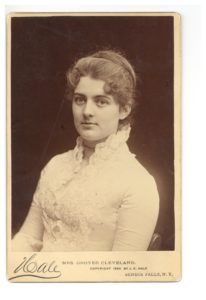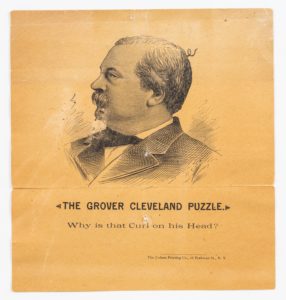In a packed box of uncatalogued cabinet photos, in between portraits of the minister Charles Cleveland and the 22nd President, I came across three portraits of a young, dark-haired woman. In each photo, she looked to be about twenty years old — attractive, well-dressed, and entirely unrecognizable to me if it weren’t for the titles printed on the cards: “Mrs. Grover Cleveland” and “President Cleveland’s Bride.” After a quick google search, I would normally take the information I needed to complete her record and move onto the next. As a 22-year-old woman, however, I was fascinated to see that Frances Folsom Cleveland entered the White House at just 21-years-old, holding the record as the youngest First Lady in American history. This tidbit at the top of her Wikipedia had me itching to learn more about the woman in black and white that I had nearly passed by. But as I ventured deeper into her story, I fell down the rabbit hole of a darker history.
 At twenty-seven years old, Grover Cleveland met the infant daughter of his law partner and close friend, Oscar Folsom, and became immediately infatuated with the child. He bought her toys and a baby carriage, becoming affectionately known as “Uncle Cleve” throughout her youth. Always a reckless driver, however, Folsom was killed in a carriage accident around the time Frances turned 11. With no will prepared, Cleveland became the executor of the Folsom estate, taking on the role of provider for Frances and her mother, Emma.[1] Emma Folsom, understandably, expected Cleveland to marry her, thus solidifying his already established role in their “family” dynamic. However, when asked by the press why he hadn’t married, he responded with, “I’m waiting for my bride to grow up.”[2] Tasteless as it may seem, the comment was laughed off as a joke, until the 49-year-old revealed his engagement to Frances Folsom, marrying her five days later in the first ever White House wedding. Their marriage took the media by storm and soon, Frances Cleveland, adored by the public, became the first First Lady to reach celebrity status.
At twenty-seven years old, Grover Cleveland met the infant daughter of his law partner and close friend, Oscar Folsom, and became immediately infatuated with the child. He bought her toys and a baby carriage, becoming affectionately known as “Uncle Cleve” throughout her youth. Always a reckless driver, however, Folsom was killed in a carriage accident around the time Frances turned 11. With no will prepared, Cleveland became the executor of the Folsom estate, taking on the role of provider for Frances and her mother, Emma.[1] Emma Folsom, understandably, expected Cleveland to marry her, thus solidifying his already established role in their “family” dynamic. However, when asked by the press why he hadn’t married, he responded with, “I’m waiting for my bride to grow up.”[2] Tasteless as it may seem, the comment was laughed off as a joke, until the 49-year-old revealed his engagement to Frances Folsom, marrying her five days later in the first ever White House wedding. Their marriage took the media by storm and soon, Frances Cleveland, adored by the public, became the first First Lady to reach celebrity status.
This wasn’t the first media storm to surround Grover Cleveland during his political career. Just after Cleveland received the Democratic nomination for President, a scandal was unearthed: a 9-year-old boy named Oscar was presented as the illegitimate son of the presidential candidate and a department store clerk named Maria Halpin. While the Republicans took immediate advantage of the scandal, Cleveland’s team scrambled to decide what should be done in response. Cleveland insisted on a platform of “honesty,” claiming all responsibility for the boy, though he did not believe that he was biologically the father. He showed the public that he saw that young Oscar was well-cared for and sent him to an orphanage where he was adopted by a respectable family.[3] Maria Halpin, for her part, was portrayed as nothing but a drunk who had slept with at least three married men in addition to Cleveland who, as the only bachelor, saw it as his duty to make sure the boy was cared for. With that, the Democrats could breathe easy. [4] Anti-Cleveland chants from the Republicans of “Ma, Ma, where’s my pa?” were soon met by the victorious Democratic response: “Headed to the White House, ha-ha-ha.”
So it was quite convenient that, in the Spring of his first year as President, the press had another Cleveland romance to sink their teeth into, as his incredibly young and utterly mesmerizing wife became a perfect distraction from the earlier negative press around Oscar. The story of his illegitimate son moved to the backburner, the public’s love of Frances all but burying it in the sands of time. Cleveland’s account prevailed in most historical mentions, with Halpin written off as a villain, her affidavit against the President long forgotten.
Yet, a pamphlet in the New-York Historical Society’s collection entitled “Tell the Truth! This is a moral question, not a political one the case of Grover Cleveland the result of the investigation by clergymen of the city of Buffalo September, 1884” cites that “abundant evidence is in hand to prove that Maria Halpin was not a bad woman when Cleveland formed her acquaintance.”[5] As it turns out, by all accounts, the true Maria Halpin was a modest woman – a widow, a mother of two young children, and a church-goer who found herself in the unlucky presence of an immoral man. Cleveland, as the accuser, was more in the habit of becoming drunk and disorderly and forming intimate relations with disreputable people than Halpin ever was. According to Halpin’s recently uncovered statement, Cleveland took her home after a meal and proceeded to sexually assault her “by use of force and violence without [her] consent.” When threatening to call the authorities, Cleveland told her “he was determined to ruin [her] if it cost him $10,000, if he was hanged by the neck for it.”[6] Once Oscar was born, Cleveland had him removed from his mother’s care, and arranged for Halpin to be sent to Providence Lunatic Asylum where, after evaluation, the medical director released her on the grounds that she was not insane, but instead the victim of political abuse. Yet, Cleveland, from his position of power, held onto the upper hand. In the end, he was true to his word in at least one sense: he did everything he could to burn her reputation to the ground.
 Historically, Grover Cleveland has been considered an above-average President, slipping in recent decades only from “near great” to squarely average despite his unpopular reputation at the end of his second term.[7] A standard search of his name first brings up the Wikipedia entry on him, which states that, among modern historians, “he has been praised for honesty, integrity, [and] adherence to his morals.” Elected by the American people twice, this man, who took violent advantage of at least one woman, destroyed her life to hold onto his power, and then groomed a young girl for marriage, is regarded as one of our country’s better leaders, and a righteous one at that. Just a few short weeks ago, when I saw a portrait of Grover Cleveland among the hundreds of cabinet photos I catalogued, I may have accepted that without a second thought. Having spent very little time on him during High School AP History classes, I had chalked his notoriety up to his one impressive feat of being elected to two non-consecutive terms. As for the names Frances Cleveland or Maria Halpin, I wouldn’t have batted an eye. Thanks to AAS and a little digging, however, I know better.
Historically, Grover Cleveland has been considered an above-average President, slipping in recent decades only from “near great” to squarely average despite his unpopular reputation at the end of his second term.[7] A standard search of his name first brings up the Wikipedia entry on him, which states that, among modern historians, “he has been praised for honesty, integrity, [and] adherence to his morals.” Elected by the American people twice, this man, who took violent advantage of at least one woman, destroyed her life to hold onto his power, and then groomed a young girl for marriage, is regarded as one of our country’s better leaders, and a righteous one at that. Just a few short weeks ago, when I saw a portrait of Grover Cleveland among the hundreds of cabinet photos I catalogued, I may have accepted that without a second thought. Having spent very little time on him during High School AP History classes, I had chalked his notoriety up to his one impressive feat of being elected to two non-consecutive terms. As for the names Frances Cleveland or Maria Halpin, I wouldn’t have batted an eye. Thanks to AAS and a little digging, however, I know better.
My heart goes out to both of these women, whose lives and relationships with the same man turned out so drastically different. Frances came out of a questionable relationship managing to win the hearts of the public, dedicating her time to charity and helping to define the office of the First Lady, despite Cleveland preferring her to stay out of the spotlight. After the death of Grover Cleveland, she became the first First Lady to remarry, this time to a man much closer to her age. Halpin was a survivor who remained strong for her children and spoke up in a time when it was arguably even harder to do so than it is now. She died in 1902 as a social pariah, fading into obscurity.
Grover Cleveland may be known to most Americans by his administration’s one fun fact, but he seems to have been, as this political cartoon in the AAS collection shows, a real pig.
[1] “First Lady Biography: Frances Cleveland.” National First Ladies’ Library, www.firstladies.org/biographies/firstladies.aspx?biography=23.
[2] Ackerman, S. J. “The first celebrity first lady: Frances Cleveland (Posted 2014-07-09 18:22:02): Frances Cleveland was 21 when she married Grover. America couldn’t get enough of her.” 2014.
[3] Serratore, Angela. “President Cleveland’s Problem Child.” Smithsonian Magazine, Smithsonian Institution, 26 Sept. 2013, www.smithsonianmag.com/history/president-clevelands-problem-child-100800/.
[4] A pamphlet in the AAS collection entitled “Cleveland’s Moral Character: Some Facts It Would Be Well To Know” details one defense in response to Cleveland’s scandal. Published by the Buffalo Committee of Independent Republicans, the pamphlet makes a case for his moral integrity, refusing to even repeat the allegations against him. Notably, though Cleveland was running as a Democrat, a large subset of Republicans supported him over their own candidate, James Blaine, who had suffered his own share of political scandals.
[5] Though no publishing information is available for this pamphlet, the title does suggest that those who produced it did so with the hope of not affiliating themselves with a specific political party. The writing does imply an endorsement of Cleveland’s Republican opposition, James G. Blaine, but does not explicitly position itself as a Republican pamphlet and offers more of a religious perspective on Cleveland’s sinfulness.
[6] Lachman, Charles. “Grover Cleveland’s Sex Scandal: The Most Despicable in American Political History.” The Daily Beast, 23 May 2011, www.thedailybeast.com/grover-clevelands-sex-scandal-the-most-despicable-in-american-political-history. In 2011, Lachman also published a book entitled A Secret Life: The Lies and Scandals of President Grover Cleveland, in which he details the Maria Halpin scandal extensively.
[7] The 2021 Presidential Historians Survey ranks Cleveland 25th out of 44, a decline that reflects modern history’s reconceptualization of post-reconstruction politics. However, it is worth noting that, though his reputation is slipping in the eyes of the educated, the average person’s first stop for information (websites such as Wikipedia) still spotlights his moral integrity.
 2021 Seiler Intern Sienna McCulley will be graduating in December 2021 with a BA in English from Amherst College, where she spent multiple semesters working in both the campus library and special collections. Her experience working with historic material at Amherst and this past summer at AAS has fueled her interest in a future career in the field.
2021 Seiler Intern Sienna McCulley will be graduating in December 2021 with a BA in English from Amherst College, where she spent multiple semesters working in both the campus library and special collections. Her experience working with historic material at Amherst and this past summer at AAS has fueled her interest in a future career in the field.
